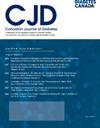抗阻训练和糖尿病教育对患有短期和长期2型糖尿病的老年人身体功能、虚弱状态和血糖的影响:对band -脆弱研究的二次分析
IF 2.3
4区 医学
Q3 ENDOCRINOLOGY & METABOLISM
引用次数: 0
摘要
背景:糖尿病病程是2型糖尿病(T2DM)管理中一个未被重视的危险因素,它可以增加并发症的风险,并可能降低生活方式干预的有效性。然而,T2DM持续时间是否会影响弹性带阻力训练干预对合并T2DM和虚弱的老年人的效果尚不清楚。目的:本分析旨在探讨16周弹性带阻力训练和糖尿病教育干预对不同T2DM病程老年人身体功能、血糖和虚弱的影响。方法:该研究纳入了130名患有2型糖尿病和体弱多病前/体弱多病的成年人(50 - 65岁),他们完成了16周的弹力带阻力训练和糖尿病教育。参与者被分类为1)短期T2DM(10年)。结果测量包括身体功能(短时体能表现电池)、血糖(A1c)和虚弱(弗里德虚弱量表)。结果:短期和长期T2DM组的参与者在干预后的身体功能和虚弱状态都有所改善(p结论:我们的研究结果表明,老年人,无论T2DM持续时间长短,在16周的弹性带阻力训练和糖尿病教育后,身体功能和虚弱状态都有所改善,而持续时间较长的T2DM患者的A1c改善更大。本文章由计算机程序翻译,如有差异,请以英文原文为准。
The Impact of Resistance Training and Diabetes Education on Physical Functioning, Frailty Status, and Glycemia in Older Adults With Short- and Long-Duration Type 2 Diabetes: A Secondary Analysis of the Band-Frail Study
Objectives
Diabetes duration is an underappreciated risk factor in type 2 diabetes (T2DM) management that can increase the risk of complications and potentially decrease the effectiveness of lifestyle interventions. However, it is unclear whether T2DM duration impacts the efficacy of an elastic band resistance training intervention for older adults living with comorbid T2DM and frailty. In this analysis we aimed to investigate and better understand the impact of a 16-week elastic band resistance training and diabetes education intervention on physical functioning, glycemia, and frailty in older adults of different T2DM durations.
Methods
This secondary analysis of the Band-Frail Study includes 130 adults (≥65 years) living with T2DM and pre-frailty/frailty who completed 16 weeks of elastic band resistance training and diabetes education. Participants were categorized as 1) short-duration T2DM (<10 years) and 2) long-duration T2DM (>10 years). Outcome measures included physical functioning (Short Physical Performance Battery), glycemia (glycated hemoglobin [A1C]), and frailty (Fried Frailty Scale).
Results
Participants in both the short- and long-duration T2DM groups improved in physical functioning and frailty status postintervention (p<0.05). The long-duration group improved A1C significantly more than the short-duration group (p=0.03).
Conclusions
Our findings suggest that older adults, irrespective of T2DM duration, improve physical functioning and frailty status after 16 weeks of elastic band resistance training and diabetes education, and that longer duration T2DM is associated with greater improvements in A1C.
求助全文
通过发布文献求助,成功后即可免费获取论文全文。
去求助
来源期刊

Canadian Journal of Diabetes
ENDOCRINOLOGY & METABOLISM-
CiteScore
4.80
自引率
4.00%
发文量
130
审稿时长
54 days
期刊介绍:
The Canadian Journal of Diabetes is Canada''s only diabetes-oriented, peer-reviewed, interdisciplinary journal for diabetes health-care professionals.
Published bimonthly, the Canadian Journal of Diabetes contains original articles; reviews; case reports; shorter articles such as Perspectives in Practice, Practical Diabetes and Innovations in Diabetes Care; Diabetes Dilemmas and Letters to the Editor.
 求助内容:
求助内容: 应助结果提醒方式:
应助结果提醒方式:


